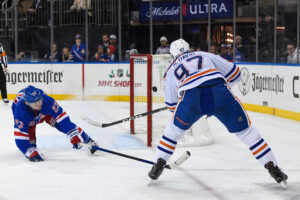NHL player development seems to always result in more questions than answers. How likely is it for a top pick to pan out? What makes a player a “steal”? Last Word On Hockey will be starting a new series on how to properly develop prospects from all different spots throughout the draft. This week’s piece involves draft picks in the back half of the first round and how they were used early in their careers.
NHL Player Development Of First-Round Picks
Between 2005 to 2015, there were 84 total selections made between 16th overall and 30th overall on forwards playing in North America. Looking at all 84 forwards, they were split into different categories. Those categories were “Forwards Deemed NHL-Ready and Brought In Immediately When Ready,” “Forwards Near NHL-Ready and Brought In Immediately When Near-Ready,” “Forwards Rushed Slightly,” “Forwards Rushed,” “Forwards Forced,” “A Little Patience,” “Patience,” and “Too Much Patience.”
There were 16 forwards who fell into the fourth category, “forced,” on the list. Of those 16 players, one made their NHL impact in their DY+1 season. That player is Stefan Matteau.
In this piece, we will be using stats from eliteprospects (raw stats) and hockey-reference (ice time). Additionally, the analytics we are using are as follows: even-strength offence goals above replacement (EVO), even-strength defence goals above replacement (EVD), wins above replacement (WAR) and goals above replacement (GAR). Those analytics are from evolving-hockey (subscription required).
NHL Player Development Of Stefan Matteau
Matteau, drafted 29th overall in the 2012 NHL draft by the New Jersey Devils, came out of the US National Team Development Program. In his DY-1 season, with the U17 squad, Matteau scored seven goals and 11 assists for 18 points in 47 games, for 0.383 points per game. That ranked 72nd among the aforementioned 84 forwards in DY-1 production. The following season, now with the U18 team, Matteau scored 15 goals and 17 assists for 32 points in 46 games, for 0.696 points per game. That ranked 77th among those same 84 forwards in DY production. Despite the unimpressive production, Matteau was still drafted in the first round and would actually make the jump to the NHL immediately.
How Was Stefan Matteau Used
Matteau would play 17 NHL games with the Devils. However, before those 17 games, he played 35 with the QMJHL’s Blainville-Boisbriand Armada. In the QMJHL, he scored 18 goals and 10 assists for 28 points, another underwhelming stat line. Once that QMJHL season was done, Matteau would average just 9:11 of time on ice per game in those 17 contests with the Devils. In that very small role in a limited sample size, Matteau scored just one goal and three total points. Analytically, he was poor. His EVO (0.1) was the only metric looked at that was over replacement level. His EVD (-0.5), WAR (-0.1) and GAR (-0.6) were all below replacement level. Matteau’s first taste of the NHL did not go well, to say the least.
In his second season, it went… worse. He didn’t step on the ice once at the NHL level and was subjected to just playing in the AHL. There, he scored 13 goals and 13 assists for 26 points in 67 games. Once again, a very uninspiring stat line for a first-round prospect who has yet to record over a point per game in his (recorded) hockey career. Yes, that includes his time in the SMAAAHL as a 16-year-old with the Notre Dame Hounds U18 team.
Small Role, No Moving Forward With Development
Matteau’s third NHL season wasn’t even really an NHL season. He played 61 AHL games, scoring 12 goals and 15 assists for 27 points. Meanwhile, he played just seven NHL games and averaged a measly 11:52 per game. In a tiny role in a small number of games, he scored one single goal. Analytically, he was just as bad as he was in year one. He recorded a better EVD (0.4) but that would be it. His EVO (-0.9) was terrible, and his WAR (-0.2) and GAR (-0.9) got worse.
Since that third NHL season, Matteau has seen 68 total NHL games across seven seasons. In that span, he scored a grand total of four goals and three assists for seven points. He played in spurts with five different NHL organizations in those seven seasons: the Devils, Montreal Canadiens, Vegas Golden Knights, Columbus Blue Jackets and Colorado Avalanche. In addition to those 68 NHL games, he also saw 253 AHL games, scoring 45 goals and 56 assists for 101 points. This upcoming season, 2022-23, Matteau will be playing in the SHL with the Linkoping HC organization, his first time overseas.
Matteau Was A Strange Pick
Stefan Matteau was a terrible selection. It cannot be understated. He did not once record over a point per game when there were many kids pre-draft scoring over a point per game in much tougher leagues. The Devils drafted him because of the old-school, outdated, hockey mindset of size over skill. The Devils drafted “the big guy.” Tanner Pearson, though he was 20 years old in the 2012 draft, was taken one pick later. Pearson did well with the GOJHL at 16 and 17 years old, with 118 points in 103 games. Then, he translated pretty well at 18/19 years old to the OHL, and then again at 19/20 years old, combining for 133 points in 126 games.
If that’s not a good comparison, due to the age of Pearson, then how about a second-round pick at 38th overall, who has since played over 200 NHL games? That player is Phillip Di Giuseppe. In his DY, he was playing NCAA hockey at 18. Prior to that, he scored 110 points in 105 OJHL games across two seasons, at 16 and 17 years old. He then scored over 0.5 points per game in the NCAA, a far more competitive league than the USDP, where Matteau was playing at the time. Simply stated, Matteau was not a good pick. He also was not ready for pro hockey when they called him up in his DY+1 season. That certainly did not help his case. A combination of being rushed and not being ready for pro hockey is what ultimately held Matteau down.
Junior league stats via Elite Prospects, NHL stats via Hockey Reference, NHL analytics via Evolving Hockey
#Habs acquire Stefan Matteau from the Devils in exchange for forward @smithpelly23. READ -> https://t.co/pTnESqRqnl pic.twitter.com/BGze2t2I5K
— Canadiens Montréal (@CanadiensMTL) February 29, 2016






